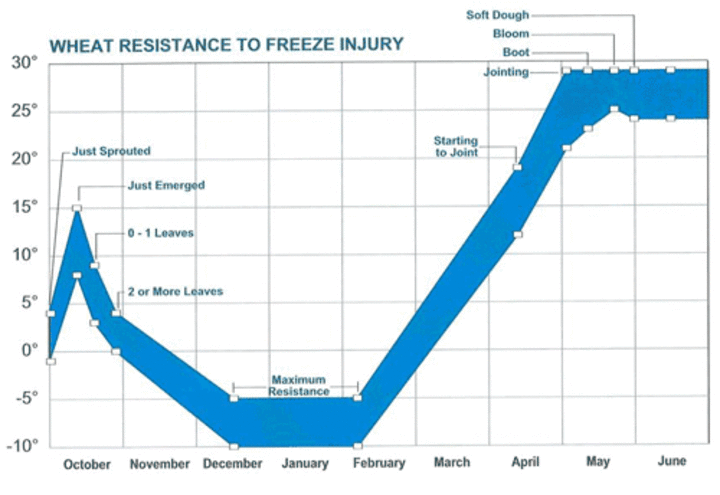
|

|
| Wheat head that is moving up the stem in a field near Arapahoe. (Photos by Robert Klein) | Wheat head emerging from the stem in a field near Lawrence. |
April 20, 2012
|
Winter wheat in most of Nebraska is about two weeks ahead of normal development. This increases the risk from freeze injury (see Figure 1 and Table 1). If the crop is not damaged by a freeze, it probably will be filling under lower temperatures, which lengthens the filling period. Temperatures above 85°F during the filling period shorten the filling period and reduce yields, even if sufficient water and nutrients are available.
Major freeze injury was seen in western Nebraska on May 9 and 10, 1981, when freezing temperatures occurred near McCook. Winter wheat, which was at a normal development stage at that time, had just headed and growers experienced major losses. Decatur County, Kansas, which adjoins Red Willow County (McCook), also had major losses to its winter wheat crop in 1981. Those counties each had the highest winter wheat losses from the freeze for each of their states. Major injury to winter wheat and other crops occurred in Nebraska by the freezes that occurred in late May 1992.
On the positive side, earlier development decreases the time for disease and insects to build to economically damaging levels. Producers and crop consultants need to scout fields regularly and treat where economical.
Resource
For more information on how a freeze affects wheat growth, see EC132, Freeze Injury to Nebraska Wheat.
Robert Klein, Extension Western Nebraska Crops Specialist, West Central REC
Bo Liu, Extension Plant Pathologist, West Central REC
Drew Lyon, Extension Cropping Systems Specialist, Panhandle REC
Greg Kruger, Extension Crops Specialist, West Central REC
| Table 1. Temperatures that cause injury to wheat at spring growth stages and symptoms and yield effect of spring freeze injury. | |||
| Growth stage |
Approximate injurious temperature (two hours) |
Primary symptoms | Yield effect |
|
|
|||
| Tillering | 12°F |
Leaf chlorosis; burning of leaf tips; silage odor; blue cast to fields |
Slight to moderate |
| Jointing | 24°F |
Death of growing point; leaf yellowing or burning; lesions, splitting, or bending of lower stem; odor |
Moderate to severe |
| Boot | 28°F |
Floret sterility; head trapped in boot; damage to lower stem; leaf discoloration; odor |
Moderate to severe |
| Heading | 30°F |
Floret sterility; white awns or white heads; damage to lower stem; leaf discoloration |
Severe |
| Flowering | 30°F |
Floret sterility; white awns or white heads; damage to lower stem; leaf discoloration |
Severe |
| Milk | 28°F |
White awns or white heads; damage to lower stems; leaf discoloration; shrunken, roughened, or discolored kernels |
Moderate to severe |
| Dough | 28°F | Shriveled, discolored kernels; poor germination | Slight to moderate |

